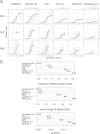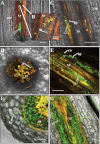Natural diversity in the model legume Medicago truncatula allows identifying distinct genetic mechanisms conferring partial resistance to Verticillium wilt
- PMID: 23213135
- PMCID: PMC3528038
- DOI: 10.1093/jxb/ers337
Natural diversity in the model legume Medicago truncatula allows identifying distinct genetic mechanisms conferring partial resistance to Verticillium wilt
Abstract
Verticillium wilt is a major threat to alfalfa (Medicago sativa) and many other crops. The model legume Medicago truncatula was used as a host for studying resistance and susceptibility to Verticillium albo-atrum. In addition to presenting well-established genetic resources, this wild plant species enables to investigate biodiversity of the response to the pathogen and putative crosstalk between disease and symbiosis. Symptom scoring after root inoculation and modelling of disease curves allowed assessing susceptibility levels in recombinant lines of three crosses between susceptible and resistant lines, in a core collection of 32 lines, and in mutants affected in symbiosis with rhizobia. A GFP-expressing V. albo-atrum strain was used to study colonization of susceptible plants. Symptoms and colonization pattern in infected M. truncatula plants were typical of Verticillium wilt. Three distinct major quantitative trait loci were identified using a multicross, multisite design, suggesting that simple genetic mechanisms appear to control Verticillium wilt resistance in M. truncatula lines A17 and DZA45.5. The disease functional parameters varied largely in lines of the core collection. This biodiversity with regard to disease response encourages the development of association genetics and ecological approaches. Several mutants of the resistant line, impaired in different steps of rhizobial symbiosis, were affected in their response to V. albo-atrum, which suggests that mechanisms involved in the establishment of symbiosis or disease might have some common regulatory control points.
Figures





References
-
- Acharya SN, Huang AJ. 2003. Breeding alfalfa for resistance to verticillium wilt: a sound strategy. In: Huang HC, Acharya SN, eds, Advances in plant disease management. Trivandrum, India: Research Signpost, pp 345–371
-
- Agrios GN. 2005. Plant pathology, 5thedn. USA, UK: Elsevier Academic Press;
-
- Ameline-Torregrosa C, Cazaux M, Danesh D, et al. 2008. Genetic dissection of resistance to anthracnose and powdery mildew in Medicago truncatula . Molecular Plant–Microbe Interactions. 21, 61–69 - PubMed
-
- Arraouadi S, Badri M, Abdelly C, Huguet T, Aouani ME. 2012. QTL mapping of physiological traits associated with salt tolerance in Medicago truncatula recombinant inbred lines. Genomics. 99, 118–125 - PubMed

